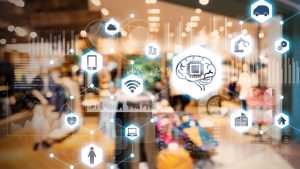 Whilst the world battled with the pandemic in 2021, the marketing and business sector had to continue to come up with creative solutions to retain and engage consumers. These solutions frequently encompassed digital technologies, also because many offline channels were often unavailable. Alongside, consumers have been relying on digital and smart technologies progressively more and in unexpected ways. As the world is finally opening up in 2022, many trends of this digital marketing transformation which arose (or were accelerated) during the pandemic are here to stay, alongside some new surprises. Like in our blog last year, we highlight some key trends for which we expect to play a crucial role in the 2022 digital marketing universe:
Whilst the world battled with the pandemic in 2021, the marketing and business sector had to continue to come up with creative solutions to retain and engage consumers. These solutions frequently encompassed digital technologies, also because many offline channels were often unavailable. Alongside, consumers have been relying on digital and smart technologies progressively more and in unexpected ways. As the world is finally opening up in 2022, many trends of this digital marketing transformation which arose (or were accelerated) during the pandemic are here to stay, alongside some new surprises. Like in our blog last year, we highlight some key trends for which we expect to play a crucial role in the 2022 digital marketing universe:
AI in marketing
By Eleonora Pantano
In recent years, the usage of AI for marketing purposes has largely increased. Indeed, it can be used to provide:
- highly customised consumer recommendations also with the support of virtual (digital) personal shoppers (online) or robotic companion (in-person), concerning products and products location, and pathways (for instance while in shopping malls or in shopping districts);
- 24/7 customer assistance through chatbots (online);
- virtual models and try on function for garments and other products (for instance through virtual mirrors available either online and in the physical stores);
- better predictions of consumer demand and trends in consumer behaviour, footfall, store flows and level of crowds; better predictions would lead to a better management of supply chain, stockpiling and stockout, and consumers panic buying;
- automatically create new product receipts and even commercials and advertising campaigns (still in a trial version at the moment).
We can expect the usage of these systems to further support the retail workers and further permitting to limit in-person interactions considering the risk of COVID-19 contagion.
However, despite these benefits for both consumers and marketers, there are also some backfire effects leading to negative consequences. First, valuable application of AI requires human, financial and technical investments and resources that marketers need to recover and maintain in a certain amount of time. Thus, how much is the application of AI sustainable for the company? Secondly, AI requires a certain trust by the end users (both employees and consumers, which is not always spontaneous). Also, to what extent will AI support and not replace human work? Will AI make consumption decisions on behalf of the consumers and to what extend will consumers accept this? Thirdly, AI involves the emergence of ethical and moral issues: since AI would reproduce human-like behaviour, it can reproduce human stereotypes and bias accordingly. Finally, the changes in consumer behaviour driven by COVID-19 demonstrated that the predictions made till that moment were (unpredictably) wrong, thus how much should marketers trust in those predictions?
negative consequences. First, valuable application of AI requires human, financial and technical investments and resources that marketers need to recover and maintain in a certain amount of time. Thus, how much is the application of AI sustainable for the company? Secondly, AI requires a certain trust by the end users (both employees and consumers, which is not always spontaneous). Also, to what extent will AI support and not replace human work? Will AI make consumption decisions on behalf of the consumers and to what extend will consumers accept this? Thirdly, AI involves the emergence of ethical and moral issues: since AI would reproduce human-like behaviour, it can reproduce human stereotypes and bias accordingly. Finally, the changes in consumer behaviour driven by COVID-19 demonstrated that the predictions made till that moment were (unpredictably) wrong, thus how much should marketers trust in those predictions?
We can thus expect the retailers to consider these questions when further investing in and integrating AI. Understanding the balance between the potential backfire and the benefits that this technology can bring is going to be key.
From intended to unintended use of AI and smart home appliances
By Davit Marikyan
 For more than a decade the acceptance and adoption of AI in private and organisational environments followed the rigorous research and development for particular use cases. The popularity of AI-powered home technologies (e.g. Amazon Alexa, Google home) is a result of their instrumentality in a home context and the associated benefits, such as a) health-related (e.g. remote monitoring, physical assistance), b) environmental (control and management of natural resources, tailored feedback and suggestions on energy consumption), c) financial (reduced utility bills) and d) hedonic and psychological benefits (entertainment and social connectivity with people beyond physical reach).
For more than a decade the acceptance and adoption of AI in private and organisational environments followed the rigorous research and development for particular use cases. The popularity of AI-powered home technologies (e.g. Amazon Alexa, Google home) is a result of their instrumentality in a home context and the associated benefits, such as a) health-related (e.g. remote monitoring, physical assistance), b) environmental (control and management of natural resources, tailored feedback and suggestions on energy consumption), c) financial (reduced utility bills) and d) hedonic and psychological benefits (entertainment and social connectivity with people beyond physical reach).
Unrealised potential of innovative technologies
However, the intended applications of AI technologies left some of their potentials underexplored and underutilised. For example, originally smart home technologies were designed to be used in a private context (e.g. for entertainment). The focus is understandable given that their benefits were intended to be realised in the home context. Consequently, the scientific community was mostly driven towards examining how such technology was utilised for private purposes. However, the benefits realised using the technology in one context can migrate to another, also known as “the spillover effect”.
Unintended adoption and spillover effects
The opportunities to understand the untapped potential of technologies came with the COVID-19 crisis. With the introduction of national lockdowns and self-isolation rules enforced by the government to fight the virus propagation, remote work was the solution to ensure business continuity. Within this shift to work-from-home, the adoption rate of smart home technologies has increased drastically. Such a trend created unique experimental conditions to examine the effect of smart home and AI-powered technologies on individuals’ wellbeing, productivity, job engagement and satisfaction. The very recent research on that front showed that smart home technology has been widely used for work purposes and could have positive implications in terms of individuals’ job engagement, wellbeing and productivity. On the other hand, such work patterns have been shown to increase the feeling of loneliness and fatigue related to technology use. In 2022, we can expect further re-negotiation between the intended and “unintended” use of smart home appliances as companies and employers continue to embrace or regulate hybrid work patterns.
Brands and metaverse
By Ana Javornik
Metaverse is all the craze. In reality though, a “true” metaverse – a parallel virtual world – is likely still years ahead and there is no certainty how that will operate, be managed and accessed. There is some agreement, however, that a metaverse is a name for a virtual space that converges with the physical reality in that it is visually and operationally much more integrated in physical surroundings in comparison to the typical internet content and activities on desktop and smartphones. This combination of virtual and augmented realities is expected to be accessed via smart devices such as smartglasses or VR headsets and it will allow for some completely new experiences as well as a realistic simulation of existing physical activities. Specifically, those are expected to be a combination of social networking, gaming, entertainment, potentially multisensory experiences and others. Despite such metaverse being “under construction”, we nevertheless see a decisive rise of numerous phenomena which will be crucial in metaverse and thus pave its way. Some of these are: virtual products; virtual assets and NFTs; virtual spaces and virtual experiences. We can expect for the brands to engage with these and look for ways of incorporating them in their strategies.
Virtual-only products
Virtual products have so far represented an important step in customer journey, as consumers could for instance try-on a virtual item before buying it. Importantly though, the virtual-only products or products intended for use in virtual spaces are now gaining prominence. Examples are brands like L’Oréal that launched virtual-only cosmetics or Gucci with their Gucci Virtual 25 sneakers and virtual bags. We can confidently expect an increase in virtual items in this year and beyond! As consumers spend more time in virtual spaces, such virtual goods will importantly contribute to their virtual identity.
Virtual assets and NFTs
The development of blockchain truly disrupted digital economy, as it brings ownability and trackable authenticity into virtual space. NFTs (non-fungible tokens) ensure that the digital assets – such as art collectibles, photos, songs or even content such as Twitter ex-CEO first Tweet – can always be authenticated and their ownership can be identified. This brought forward a new stream of digital economy. Brands are taking notice and some investing considerably in creating their own NFTs. We can expect creative approaches as brands engage with this new form of virtual asset.
Virtual spaces and virtual experiences
While live-streaming and online events were already on the rise last year, their importance keeps growing. Amazon’s Twitch is one of the biggest streaming platforms for gaming, esports and related content, where everyone can broadcast and join in, boasting with millions of daily broadcasts. Live-streaming virtual spaces are important for brands as they can engage with consumers in new ways, like for instance via virtual product launch. Here, a collaboration with gaming companies will likely prove crucial – companies such as Roblox and Epic Games have already managed to build impressive virtual world for entertainment and socialising. The challenges for brands in the coming year and beyond will be to understand how they can either create or be part of the virtual experiences that are most meaningful to consumers, be that integrating a brand into a game, co-branding a concert, advertising in Fortnite – or myriad other possibilities.
TikTok and LGBTQIA+ Consumer Identity Projects
By Mario Campana
Have you ever promised yourself to watch only one last video on TikTok and an hour and a half later you are still watching one video after the other? It has happened to all of us. Thanks to its algorithm, TikTok has made video consumption, through memeification, and video creation very easy for consumers. Consumers can work with the algorithm and create customised content through filters, music and more, in a matter of minutes. For this reason, the platform has been particularly functional to the formation of identities of young consumers belonging to different minorities.
 For instance, LGBTQIA+ consumers, especially queer, transgender and gender-non-conforming, have found this platform to be a safe space. A recent article from Vox discusses how through a filter that allows people to see themselves either as male or as female, TikTok has provided queer people with a tool to question their gender identification. Furthermore, it has provided a space to discuss these issues through the hashtag #questioninggender globally. LGBTQIA+ consumers’ identities are not only performed through the usage of filters but through songs, memes, drag performances, fashion, emojis, dance moves, and more. TikTok gives the possibility of infinite combinations of LGBTQIA+ identity projects that can enhance consumers’ self-esteem and wellbeing.
For instance, LGBTQIA+ consumers, especially queer, transgender and gender-non-conforming, have found this platform to be a safe space. A recent article from Vox discusses how through a filter that allows people to see themselves either as male or as female, TikTok has provided queer people with a tool to question their gender identification. Furthermore, it has provided a space to discuss these issues through the hashtag #questioninggender globally. LGBTQIA+ consumers’ identities are not only performed through the usage of filters but through songs, memes, drag performances, fashion, emojis, dance moves, and more. TikTok gives the possibility of infinite combinations of LGBTQIA+ identity projects that can enhance consumers’ self-esteem and wellbeing.
This becomes particularly relevant for brands. Recently, the LGBTQIA+ market, including young queer consumers and consumers that identify as fluid, has been defined as the “$1 trillion blindspot”, as not enough brands cater to this market (Oakenfull 2021). Overall, there is a general lack of understanding of how brands can engage with the LGBTQIA+ market meaningfully, without exacerbating stereotypes and discrimination. TikTok can help in this direction, as it is a creator of popular culture where brands can learn about LGBTQIA+ culture. In this space, there are very tangible opportunities for brands to become part, partners, allies, or enablers of LGBTQIA+ identities projects in 2022.
Obviously, there are many other relevant trends in addition to these that we highlighted. One thing is certain – this year is going to see some very exciting digital marketing developments!

